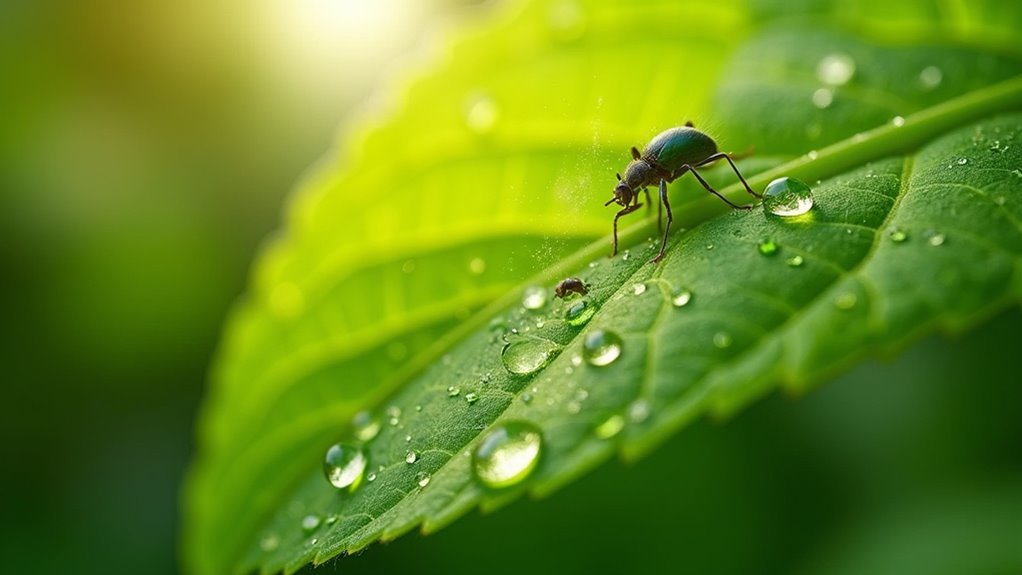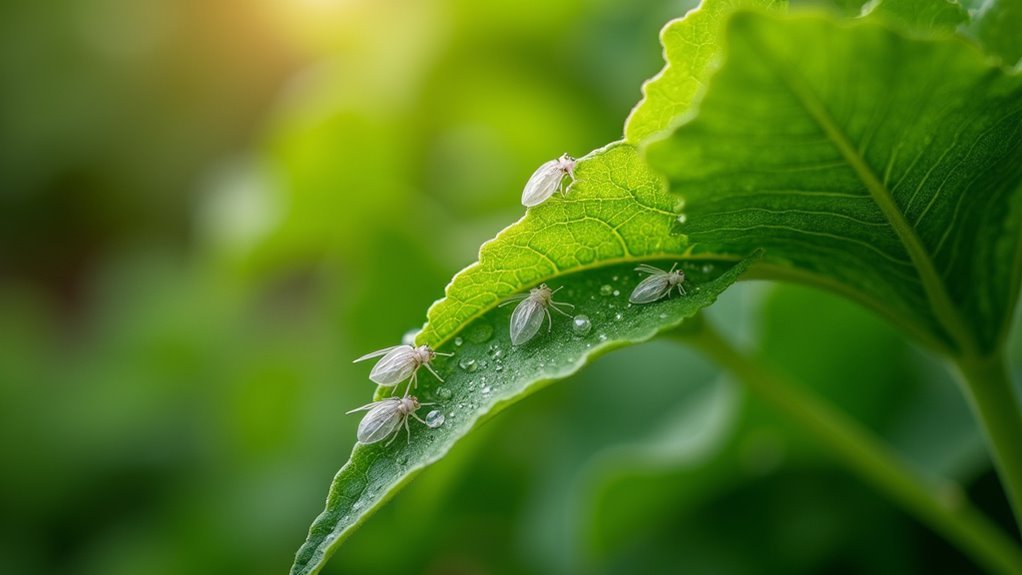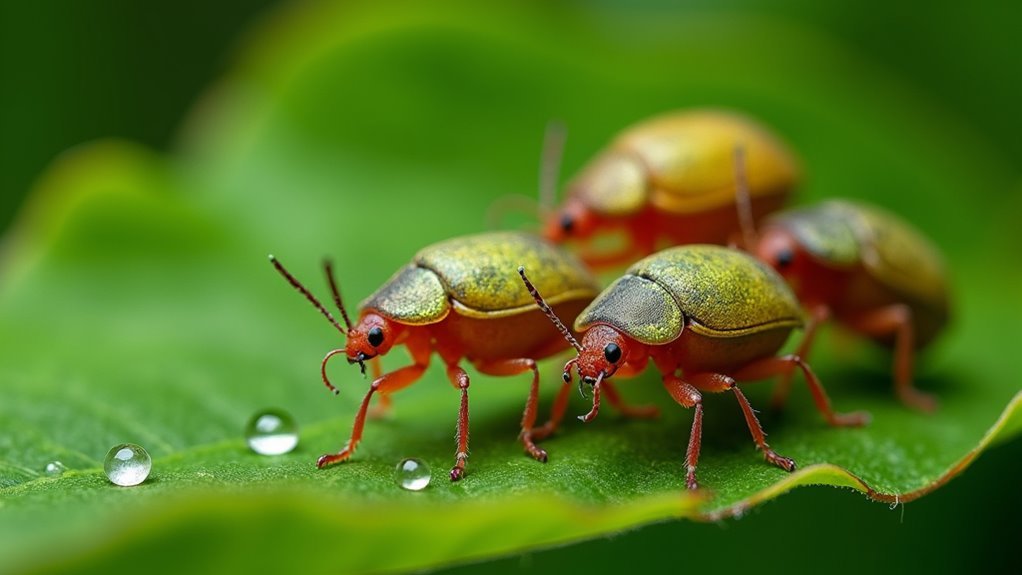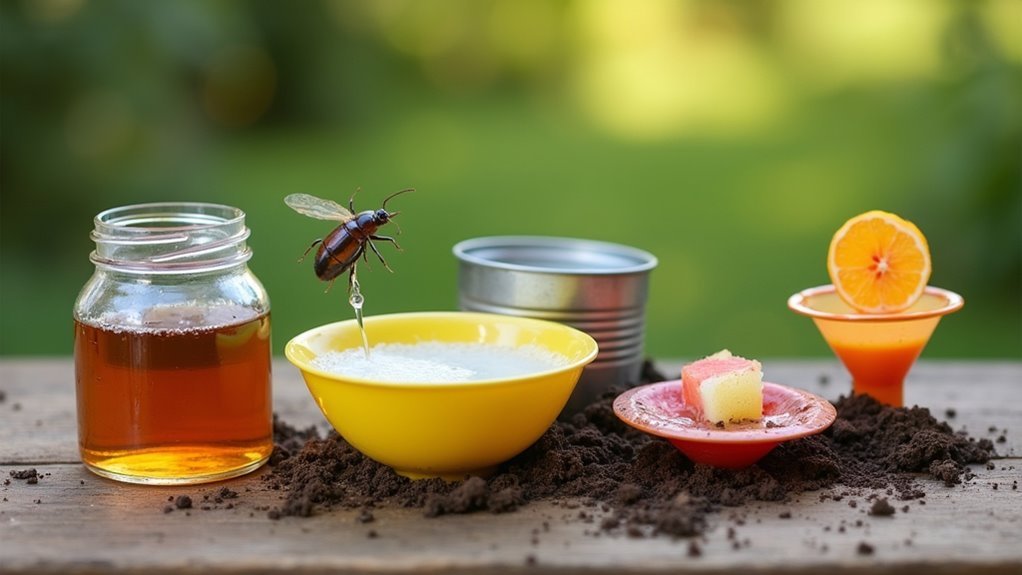Boron spray effectively eliminates a wide range of plant pests by targeting their nervous and digestive systems. You’ll find it particularly effective against soft-bodied insects like aphids, whiteflies, thrips, spider mites, and scale insects, causing paralysis and death within 24-48 hours. It also controls mealybugs and garden ants by disrupting their metabolism and allowing infected insects to carry the treatment back to their colonies. The spray even prevents fungal diseases like powdery mildew while enhancing your plant’s natural defenses for thorough protection.
Understanding Boron-Based Pest Control Mechanisms

When you’re dealing with persistent plant pests, boron-based compounds offer a unique approach that targets insects through multiple biological pathways.
These mechanisms primarily disrupt your pests’ nervous systems, causing paralysis and eventual death through contact or ingestion. Boric acid and similar compounds work as slow-acting poisons, meaning infected insects can carry the substance back to their colonies before succumbing, effectively eliminating entire infestations.
You’ll find these treatments effective against ants, cockroaches, spiders, and fleas because they simultaneously attack digestive processes and damage exoskeletons.
The slow-acting nature guarantees thorough colony penetration, while the compounds break down quickly in soil, reducing environmental risks. This multi-pathway approach makes boron-based solutions particularly valuable for extensive pest management.
Aphids and Soft-Bodied Insects Targeted by Boron Spray
When you’re dealing with aphid infestations, boron spray targets these soft-bodied pests by breaking down their entire colony structure through systematic elimination.
You’ll find that boron effectively controls aphids and similar insects because it penetrates their vulnerable bodies and interferes directly with their digestive systems.
This targeted approach disrupts both individual insects and the broader colony, stopping reproduction cycles and preventing further plant damage.
Aphid Colony Disruption
Although aphids seem resilient in their destructive feeding patterns, boron spray effectively disrupts their colonies by targeting their reproductive systems and dramatically reducing population growth.
When you apply boron treatments, you’re interfering with aphids’ ability to multiply rapidly, which breaks their cycle of plant damage. This pest control method works because aphids ingest boron while feeding on treated plants, causing digestive disruption that leads to mortality within 24-48 hours.
You’ll find that boron spray doesn’t just eliminate individual aphids—it systematically weakens entire colonies by preventing successful reproduction.
This targeted approach means you’re addressing the root cause of infestations rather than just treating symptoms. The result is long-term population control that protects your plants from ongoing aphid damage.
Soft-Bodied Insect Control
Beyond aphids, boron spray targets a wide range of soft-bodied insects that plague your garden, including thrips, whiteflies, and small caterpillars. The borax-based solution works by disrupting their digestive systems and causing rapid dehydration upon contact. You’ll notice affected insects dying within hours of application.
| Insect Type | Primary Damage | Boron’s Action |
|---|---|---|
| Thrips | Leaf stippling, silvering | Contact kill, dehydration |
| Whiteflies | Honeydew, yellowing leaves | Digestive disruption |
| Small caterpillars | Leaf holes, defoliation | System breakdown |
| Spider mites | Webbing, bronze leaves | Cellular damage |
| Scale insects | Stunted growth | Penetration barriers |
Regular applications prevent outbreaks while enhancing your plants’ natural defenses. This environmentally friendly approach reduces dependence on toxic pesticides, promoting healthier gardens and improved yields.
Digestive System Interference
Boron’s lethal effectiveness against aphids and soft-bodied insects stems from its ability to sabotage their digestive systems at the cellular level.
When these pests consume boron-treated plant material, the mineral infiltrates their gut and wreaks havoc on essential metabolic processes.
You’ll notice digestive system interference occurs as boron disrupts nutrient absorption pathways, preventing these insects from extracting crucial energy sources from their food.
This metabolic disruption starves them from within, regardless of how much they feed.
The interference compounds over time, causing progressive weakness and organ failure.
Within 24-48 hours of consumption, affected aphids and soft-bodied insects succumb to this internal assault, making boron spray an efficient biological weapon against these destructive garden pests.
Spider Mites and Microscopic Pest Elimination
When spider mites invade your garden, they’ll quickly drain the life from your plants by piercing leaves and sucking out essential sap. These microscopic pests cause extensive damage across various plant species, creating yellowing, stippling, and weakened foliage that compromises your garden’s health.
Spider mites pierce plant leaves and drain essential sap, causing yellowing, stippling, and weakened foliage that compromises garden health.
Boron spray provides an effective solution for eliminating spider mites and other microscopic threats. Once these pests ingest the boron compound, it disrupts their digestive systems, causing death within 24-48 hours.
You’ll appreciate that boron compounds remain less toxic to beneficial insects and pollinators compared to harsh chemical alternatives.
Beyond elimination, boron spray enhances plant vigor when applied as foliar treatment, helping your plants recover from infestations while reducing future outbreak risks.
Regular applications create long-term pest management solutions for both ornamental and agricultural settings.
Whitefly Control Through Boron Applications

You’ll find that boron spray disrupts whitefly metabolism at the cellular level, interfering with their ability to process nutrients and reproduce effectively.
Proper application involves targeting the undersides of leaves where whiteflies congregate, using a fine mist to guarantee thorough coverage of feeding and breeding areas.
Within two to three weeks of consistent treatment, you can expect to see significant population decline as the reproductive cycle breaks down and existing adults weaken.
Boron Disrupts Whitefly Metabolism
Although whiteflies appear resilient, boron spray targets their metabolic processes with remarkable precision. When you apply boron to affected plants, it disrupts the insects’ ability to process essential nutrients, creating a cascade of physiological failures that ultimately prove fatal.
The metabolic disruption occurs through three key mechanisms:
- Nutrient Processing Interference – Boron blocks whiteflies’ ability to absorb and utilize crucial nutrients from plant sap.
- Cellular Function Breakdown – Essential metabolic pathways become compromised, preventing normal cellular operations.
- Gradual System Failure – The insects experience progressive weakness leading to death within days.
This slow-acting poison effect guarantees thorough population control while maintaining environmental safety.
You’ll notice considerably reduced whitefly numbers without harming beneficial insects, making boron an effective and sustainable pest management solution.
Application Methods Against Whiteflies
Understanding how boron disrupts whitefly metabolism sets the foundation for implementing effective application strategies that maximize pest control results.
You’ll achieve ideal outcomes by applying boron as a foliar spray directly onto leaves where whiteflies feed and reproduce. Using borax mixed with water creates an effective solution that targets these pests at their source.
You should spray during early morning or evening hours when whiteflies are most active and temperatures are cooler. Regular applications every 7-10 days help maintain consistent control and prevent new infestations.
You can integrate boron treatments with other pest management strategies without harming beneficial insects, making it an environmentally friendly choice that’s less toxic than traditional insecticides.
Whitefly Population Reduction Timeline
When you apply boron spray to whitefly-infested plants, you’ll notice population reductions beginning within the first 24 to 48 hours as the solution acts as a contact insecticide upon direct exposure.
The timeline for significant whitefly control follows this pattern:
- Initial Impact (0-48 hours): Boron kills insects on contact, causing immediate mortality as it disrupts their feeding mechanisms and overall health.
- Reproductive Disruption (1-2 weeks): You’ll observe declining populations as boron interferes with their reproductive capabilities and development cycles.
- Sustained Control (2+ weeks): Regular applications maintain up to 70% population reduction while simultaneously strengthening plant resilience against future infestations.
This dual-action approach creates an inhospitable environment for whiteflies while addressing potential boron deficiencies in your plants, making them naturally more resistant to pest problems.
Scale Insects and Their Vulnerability to Boron Compounds

Scale insects present a persistent challenge for gardeners since these sap-feeding pests weaken plants by draining their essential nutrients and can quickly spread throughout your garden.
You’ll find that boron compounds effectively target these resilient insects through multiple mechanisms. When scale insects ingest boron while feeding on treated plant sap, the compound disrupts their digestive systems and causes fatal dehydration.
The slow-acting nature works to your advantage—infected insects carry the compound back to their colonies, eliminating entire populations. Boric acid applications not only kill existing scale insects but also strengthen your plants’ natural defenses against future infestations.
Boric acid’s delayed action allows infected scale insects to spread the treatment throughout their colonies, creating comprehensive population control while boosting plant immunity.
You can apply boron as a foliar spray for direct contact, providing safer pest control than harsh chemical alternatives.
Thrips Management Using Boron-Based Solutions
While scale insects attack plants through direct sap feeding, thrips pose a different threat by rasping and scraping plant surfaces to access cellular fluids.
You’ll find that boron-based solutions effectively combat these destructive insects through multiple mechanisms that target both the pest and plant health.
Boron applications provide thorough thrips control by:
- Disrupting reproductive cycles – Interfering with thrips’ ability to reproduce and multiply in your garden
- Strengthening plant tissues – Creating less appealing feeding sites that deter thrips attacks
- Enabling rapid absorption – Delivering quick results when applied as foliar sprays
You can maintain consistently low thrips populations through regular boron monitoring and application.
This effective pest management strategy not only controls current infestations but also builds plant resilience, ultimately supporting healthier development and improved yields in your crops.
Fungal Disease Prevention With Boron Treatments
You’ll find that boron treatments offer powerful antifungal properties that can greatly reduce fungal diseases in your plants by disrupting fungal cellular processes and enhancing plant resilience.
Your disease prevention strategy should focus on regular foliar applications and soil amendments, particularly in boron-deficient areas where crops like tomatoes and cucumbers are most vulnerable to infections.
The timing of your boron treatments is essential – you’ll get the best results when you apply them preventively during early growth stages and before high-risk periods for fungal development.
Boron’s Antifungal Properties
Fungal diseases can devastate your garden, but boron treatments offer a powerful defense mechanism that works at the cellular level. Boron’s antifungal properties disrupt fungal cell wall synthesis, preventing pathogens from growing and reproducing effectively. This micronutrient inhibits specific metabolic processes in harmful fungi, creating an inhospitable environment for diseases like powdery mildew and root rot.
Here’s how boron protects your plants:
- Strengthens plant defenses – Boron builds stronger cell walls and improves tissue integrity, making plants naturally resistant to infections.
- Reduces disease severity – Regular applications decrease the incidence of common fungal problems in crops and ornamentals.
- Improves soil health – Boron supplementation creates a balanced microbiome that outcompetes harmful fungi, reducing your reliance on chemical fungicides.
Disease Prevention Methods
Since prevention proves more effective than treatment when dealing with fungal diseases, implementing strategic boron applications creates a proactive defense system for your garden. These disease prevention methods focus on strengthening plant defenses before pathogens strike. You’ll strengthen cell walls, making them less susceptible to fungal penetration while boosting natural defense compound production.
| Application Method | Frequency | Target Diseases |
|---|---|---|
| Soil Drenching | Monthly | Root rot, damping-off |
| Foliar Spray | Bi-weekly | Powdery mildew, leaf spots |
| Preventive Treatment | Seasonal | General fungal prevention |
| Combined Application | As needed | Extensive protection |
| Maintenance Dose | Quarterly | Long-term immunity |
Regular boron applications enhance other fungicides’ effectiveness, creating synergistic protection. You’ll notice improved plant vigor and reduced disease incidence, particularly in boron-deficient soils where fungal problems typically worsen.
Treatment Application Timing
When determining ideal timing for boron treatments against fungal diseases, you’ll achieve maximum protection by aligning applications with specific plant growth phases and environmental conditions.
Treatment application timing becomes critical for preventing fungal infections before they establish.
You’ll want to focus on these key timing strategies:
- Pre-weather application – Apply foliar sprays before wet conditions that promote fungal growth.
- Early growth stages – Target treatments during initial plant development when preventative measures are most effective.
- Regular intervals – Maintain consistent applications every 4-6 weeks throughout the active growing season.
Conduct tissue analysis before applying treatments to determine precise timing and dosage requirements.
You’ll strengthen plant resistance most effectively when applying boron during stress periods or when deficiency symptoms appear.
Mealybug Infestations Controlled by Boron Spray
Although mealybugs pose a persistent threat to plant health, boron spray offers an effective solution that disrupts their digestive systems and eliminates them within 24-48 hours of consumption.
You’ll find boron acts as a slow-acting poison that’s safer than harsh chemical pesticides while protecting beneficial insects. Regular applications create an unfavorable environment that reduces mealybug populations effectively.
| Application Method | Timeline | Plant Benefits |
|---|---|---|
| Foliar spray | 24-48 hours kill rate | Reduced plant stress |
| Soil drench | Strengthens plant vigor | Enhanced growth |
| Regular treatment | Population control | Healthier foliage |
| Preventive use | Stops infestations | Improved resistance |
| Combined approach | thorough control | Maximum protection |
When you use boron as a soil drench, it strengthens plants against future attacks by improving overall plant health and vigor.
Powdery Mildew and Boron’s Antifungal Properties
While powdery mildew creates a white, dusty coating that weakens plants and reduces yields, boron spray provides a natural antifungal solution that strengthens your plants’ defenses from within.
When you apply boron as a foliar spray, you’re targeting this persistent fungal disease through multiple mechanisms:
- Cell Wall Strengthening – Boron reinforces plant cell walls, creating a stronger barrier against fungal penetration.
- Spore Development Disruption – The mineral interferes with powdery mildew spore reproduction and growth cycles.
- Enhanced Plant Vigor – Regular applications promote overall plant health while preventing future infections.
You’ll notice healthier foliage and reduced disease pressure when using boron preventively.
This approach lets you manage powdery mildew without relying heavily on synthetic fungicides, making it an environmentally conscious choice for your garden’s long-term health.
Leaf Miners and Boron’s Systemic Pest Control
Beyond surface fungal issues, your plants face threats from pests that tunnel directly through their leaves. Leaf miners create winding trails as they feed between leaf surfaces, weakening your plants and reducing photosynthesis.
Boron spray, particularly sodium tetraborate, offers effective systemic control against these destructive pests. When you apply boron through foliar sprays or soil drenches, the compound absorbs into plant tissues and remains active for extended periods.
As leaf miners consume treated plant material, boron disrupts their digestive systems, considerably reducing populations. This systemic approach means you can’t simply wash away the protection.
Research shows boron applications dramatically decrease leaf miner infestations while improving crop yields. Unlike harsh chemicals, boron’s low toxicity protects beneficial insects and humans, making it ideal for gardens and agricultural settings.
Root Rot Prevention Through Boron Soil Applications
When soil moisture creates perfect conditions for fungal pathogens, your plant’s root systems become vulnerable to devastating rot that can destroy entire crops.
Boron soil applications provide a powerful defense by strengthening your plant’s natural resistance mechanisms. This essential micronutrient enhances cell wall formation, creating structural barriers that pathogens can’t easily penetrate.
Strategic boron applications protect your crops through:
- Enhanced root vigor – Boron promotes stronger, more resilient root systems that resist pathogen invasion
- Improved nutrient uptake – Better nutrient absorption supports healthy root development and disease resistance
- Optimal soil conditions – Regular boron monitoring prevents environments that favor root rot pathogens
Garden Ant Control With Boron-Based Formulations
Garden ants present a different challenge that requires targeted intervention strategies. You can effectively control these pests using boron-based formulations like borax, which disrupts their digestive systems and causes fatalities within 24-48 hours.
Set up ant bait stations containing boron in areas where you’ve noticed ant activity. Worker ants will carry the poison back to their colonies, eliminating entire nests rather than just individual insects.
Boron’s slow-acting nature works to your advantage, allowing ants to share the bait with colony members before succumbing. This approach proves more effective than fast-acting poisons that kill carriers before they reach the nest.
You’ll appreciate that boron presents minimal environmental risks compared to traditional pesticides while considerably reducing ant populations and protecting your garden plants from pest damage.
Application Methods for Maximum Pest Elimination Effectiveness
Effective application techniques determine whether your boron spray delivers peak pest elimination results or falls short of expectations.
Your choice of application methods directly impacts how well the treatment reaches target pests and protects your plants.
Strategic application method selection determines whether your boron treatment successfully eliminates pests or fails to deliver the protection your plants need.
Three Essential Application Methods for Optimal Results:
- Foliar spraying – Apply during early morning or late afternoon to minimize evaporation while ensuring thorough coverage of all plant surfaces for peak pest contact.
- Soil drenching – Target root zone pests by saturating the soil around affected plants, allowing boron to eliminate insects feeding below ground.
- Combination approach – Use both foliar and soil applications for extensive pest control, applying at recommended rates of 0.5-1 oz. per 1,000 sq. ft. for balanced effectiveness.
Frequently Asked Questions
What Plants Benefit From Boron?
You’ll see great results when applying boron spray to fruit trees, vegetables like broccoli and cabbage, ornamental palms, flowering plants, and leguminous crops such as beans and peas for ideal growth.
What Bugs Does Boric Acid Get Rid Of?
You’ll find boric acid eliminates ants, cockroaches, termites, and fleas by disrupting their digestive systems. It damages their exoskeletons and acts as slow-acting poison, killing pests within 24-48 hours.
Is Too Much Boron Bad for Plants?
Yes, you’ll harm your plants with excessive boron. Levels above 2.0 ppm cause leaf burn, wilting, yellowing, and stunted growth. You should maintain 0.5-1.0 ppm and test soil regularly to prevent toxicity.
Why Is Boric Acid Banned in the USA?
You’ll find boric acid’s banned in certain USA applications because it’s linked to reproductive toxicity and endocrine disruption. The EPA’s classified it as a risky pesticide that can irritate skin, eyes, and respiratory systems.
In Summary
You’ll find boron spray effectively eliminates multiple plant pests when applied correctly. It’s particularly successful against aphids, spider mites, whiteflies, scale insects, and leaf miners through contact and systemic action. You can also use boron soil applications to prevent root rot and control garden ants. Remember that proper application timing and concentration are vital for maximizing effectiveness while avoiding plant damage. Follow label instructions carefully for best results.





Leave a Reply